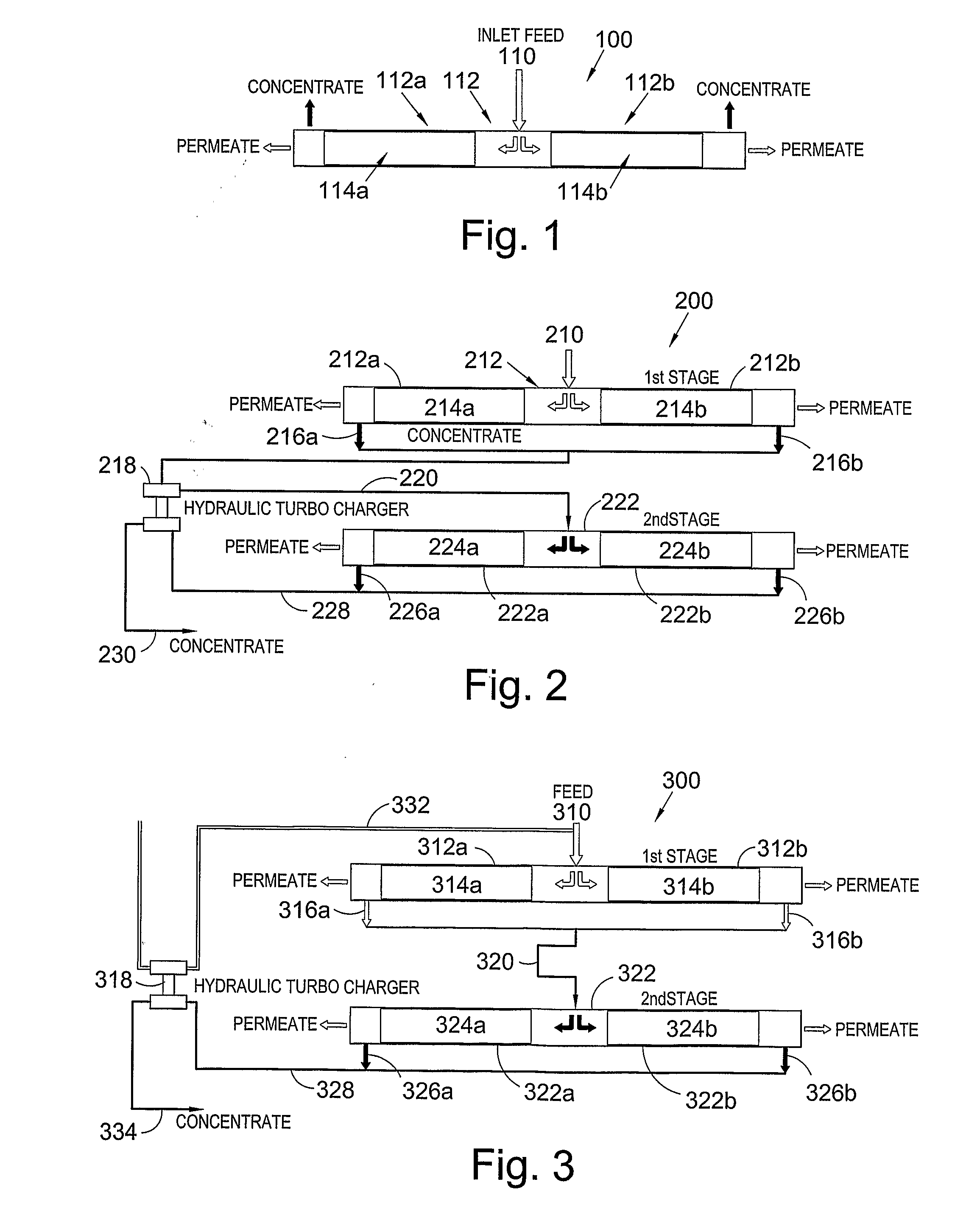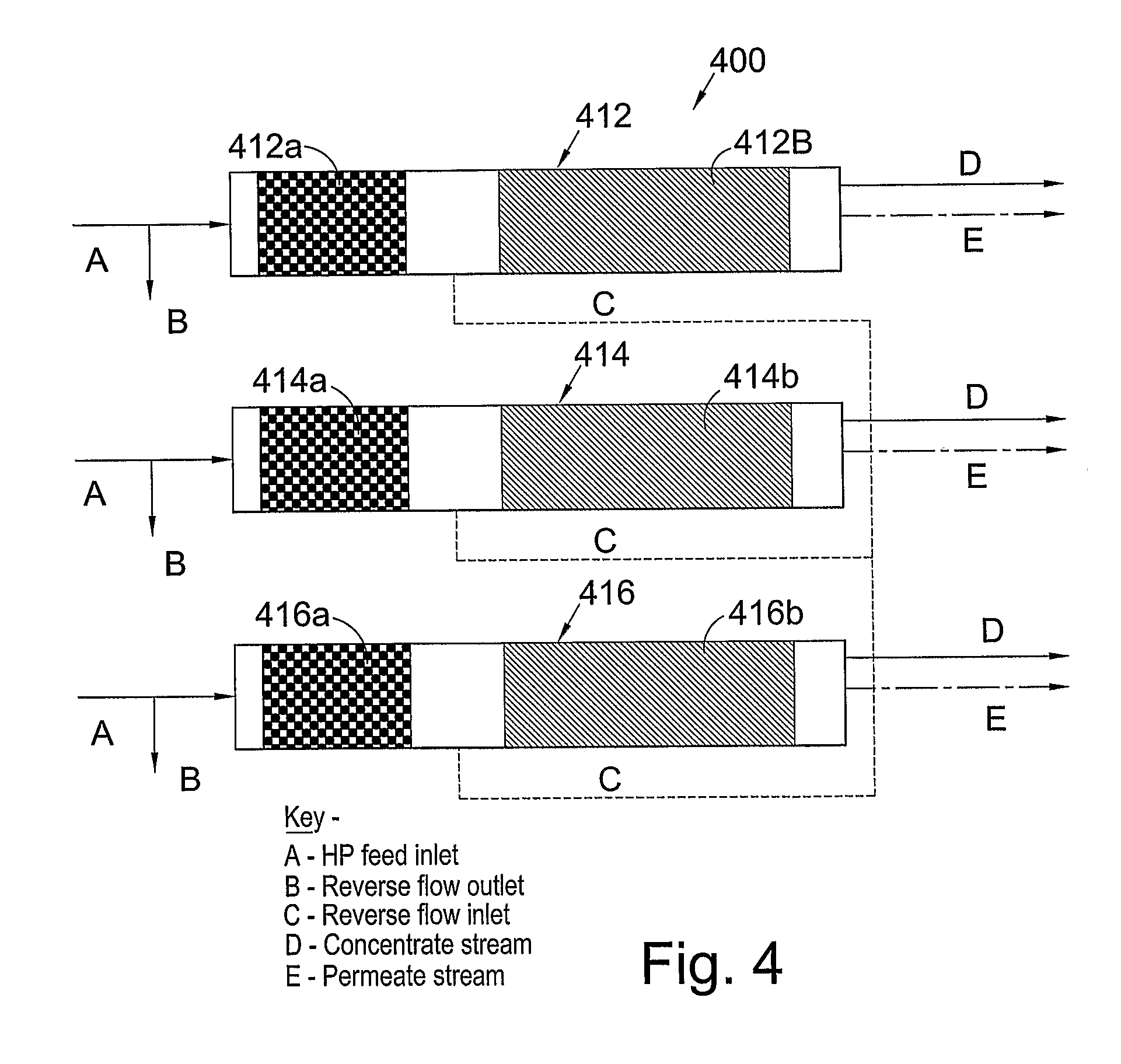Filtration system
a technology of membrane systems and filtration membranes, applied in the direction of membranes, filtration separation, separation processes, etc., can solve the problems of media bed filtration, unsuitable and/or uneconomical to run in many applications, and inability to achieve the effect of reducing the concentration of ions
- Summary
- Abstract
- Description
- Claims
- Application Information
AI Technical Summary
Benefits of technology
Problems solved by technology
Method used
Image
Examples
example 1
[0136]FIG. 7 represents a comparison of a membrane vessel arrangement using eight element vessels according to the present invention with a prior art arrangement of six element membrane vessels located end to end.
[0137]As shown in FIG. 7, the membrane vessel arrangement according to the present invention has a significant reduction in footprint with a volume of 990 compared to the prior art arrangement of 1056. This is extremely important when working offshore where space on oil platforms is extremely limited.
[0138]FIG. 7 shows that prior art eight inch (203.2 mm) systems have a volume of 1056 and sixteen inch (406.4 mm) systems have a volume of 896. In contrast, using the arrangements of the present invention, a significant saving in volume may be found with the present invention eight inch (203.2 mm) system units having a volume of 990 and the sixteen inch (406.4 mm) system having a volume of 480. As will be understood, these are significant space saving reductions.
example 2
Improved Power Consumption
[0139]In this Example, we have used the membrane vessel arrangement 200 shown in FIG. 2.
[0140]Using Hydraulic Turbocharger (HTC) for the following conditions:
1st stage membrane pressure requirement: 28 barg (2.9 MPa)1st stage concentrate outlet pressure:25.5 barg (2.65 MPa)2nd stage inlet pressure requirement:31.5 barg (3.25 MPa)2nd stage concentrate outlet pressure: 23 barg (2.4 MPa)(without boost)System recovery:75%Pump Efficiency (Hydraulic):75%Pump Motor efficiency:90%HTC Efficiency:74.3% HTC Pressure boost: 6.2 barg (0.72 MPa)
Based on 100 m3 / h system feed flow:
KWkW / m3Pump power without HTC147.81.48Pump power with HTC135.41.35Saving with HTC8.4%
There is therefore a power saving of 8.4% by using a hydraulic turbocharger.
example 3
Improved Power Consumption
[0141]Using the membrane vessel arrangement shown in FIG. 3, improved power consumption is found.
[0142]Using a Hydraulic Turbocharger (HTC) for the following conditions:
Inlet membrane pressure requirement:35 barg (3.6 MPa)Concentrate outlet pressure:31 barg (3.1 MPa)System recovery:75%Pump Efficiency (Hydraulic):75%Pump Motor efficiency:90%HTC Efficiency:74.3% HTC Pressure boost: 4.6 barg (0.56 MPa)
Based on 100 m3 / h system feed flow:
KWkW / m3Pump power without HTC147.81.48Pump power with HTC128.31.32Saving with HTC11%
There is therefore a power saving of 11% using a hydraulic turbocharger.
Summary
[0143]Some improvements using the membrane vessel arrangements according to the present invention are summarised as follows:
System withCartridgeSystem withPresentfilter pre-Media filterInventiontreatment onlypretreatmentArea CalculationMedia Filters——157 m2Cartridge Filters— 44 m2 44 m2SRU Pumps108 m2108 m2108 m2CIP 22 m2 22 m2 22 m2Membrane Trains162 m2149 m2149 m2To...
PUM
| Property | Measurement | Unit |
|---|---|---|
| Time | aaaaa | aaaaa |
| Energy | aaaaa | aaaaa |
| Permeation properties | aaaaa | aaaaa |
Abstract
Description
Claims
Application Information
 Login to View More
Login to View More - R&D
- Intellectual Property
- Life Sciences
- Materials
- Tech Scout
- Unparalleled Data Quality
- Higher Quality Content
- 60% Fewer Hallucinations
Browse by: Latest US Patents, China's latest patents, Technical Efficacy Thesaurus, Application Domain, Technology Topic, Popular Technical Reports.
© 2025 PatSnap. All rights reserved.Legal|Privacy policy|Modern Slavery Act Transparency Statement|Sitemap|About US| Contact US: help@patsnap.com



